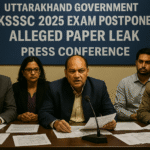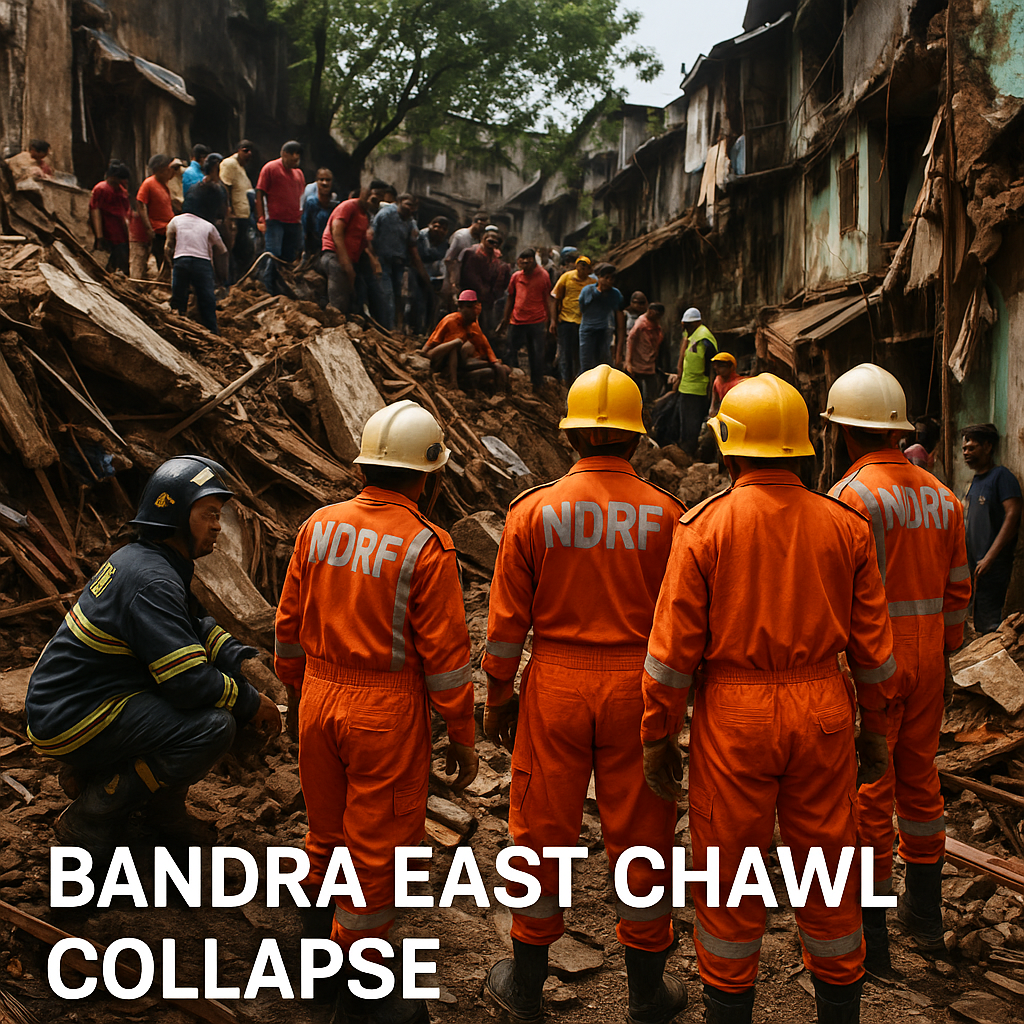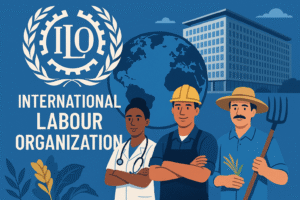
Tragedy Strikes Bandra East: Three-Storey Chawl Collapse Kills 2, Rescue Ops Continue

A three-storey chawl collapsed in Bandra East, Mumbai, killing two and injuring six. Here are the latest updates, rescue efforts, and safety concerns raised by this tragic incident.
Table of Contents
Published: July 18, 2025
Last Updated: July 18, 2025
Category: Urban Infrastructure & Public Safety
News Overview: Understanding the Structural Failure in Bandra East
On Friday, July 18, 2025, at approximately 5:56 AM, a three-storey residential chawl in Mumbai’s Bharat Nagar area underwent sudden structural failure. Located in the densely populated Bandra East neighborhood near the Namaj Committee Masjid and close to the Bandra-Kurla Complex, the incident affected multiple families and triggered an immediate large-scale emergency response operation.
The building failure, identified as chawl number 37, marked a significant urban infrastructure incident reflecting broader safety concerns within Mumbai’s aging residential stock. Emergency services rapidly deployed to the scene, initiating complex rescue and recovery procedures that would continue throughout the day and into subsequent days.
This incident represents one of several building collapses documented in major Indian urban centers during 2025, highlighting persistent challenges related to aging infrastructure, inadequate maintenance systems, and structural vulnerability factors common to densely populated residential areas.
The Incident: Timeline and Initial Conditions
Pre-Dawn Structural Failure
The building collapse occurred during early morning hours when many residents remained inside their homes. The precise moment of structural failure coincided with a period of relative calm before daily activity levels increased, potentially reducing casualties compared to scenarios where collapse occurred during peak occupancy periods.
Preliminary evidence suggests that the upper floors and roofing structure failed first, with subsequent cascading effects as the building’s structural integrity was compromised. This sequencing indicates a primary failure point that propagated through dependent structural elements rather than simultaneous uniform collapse.
The location’s proximity to the Bandra-Kurla Complex, a major commercial district, meant that emergency responders could rapidly mobilize resources from nearby stations. Geographic positioning factors influenced response speed and resource availability during initial phases of the emergency.
Immediate Environmental Factors
Weather conditions at the time included moisture and atmospheric pressure patterns typical of Mumbai’s monsoon season. The timing occurred during July, which represents the peak monsoon period for the Mumbai region, introducing precipitation and humidity factors that potentially influenced structural stress levels.
Wind patterns and atmospheric conditions during the early morning hours created specific structural loading conditions. Understanding these environmental parameters assists investigation teams in determining whether external environmental factors contributed to timing of the failure.
Building orientation and exposure to prevailing wind patterns throughout the structure’s standing period may have created stress concentrations at specific points. These environmental factors interact with structural degradation patterns over extended building lifetimes.
Emergency Response Operations: Coordinated Rescue Efforts
Agencies and Resource Deployment
The emergency response mobilized multiple specialized services with distinct technical capabilities. The Mumbai Fire Brigade deployed eight fire engines representing substantial equipment resources for a building collapse scenario. Fire service personnel brought specialized tools including hydraulic rescue equipment, cutting mechanisms for concrete and metal, and detection systems for locating individuals within debris.
The Mumbai Police contributed personnel for scene security, traffic management, and coordination with civilian populations. Police presence enables controlled access to collapse sites while preventing additional injuries from untrained individuals attempting self-directed rescue activities.
The Brihanmumbai Municipal Corporation (BMC) provided heavy machinery including excavators and dump trucks essential for debris removal and structural stabilization. Municipal personnel contributed administrative coordination and logistical support including temporary power, water supply, and sanitation facilities for extended operations.
Classification of Emergency Response Level
The Mumbai Fire Brigade declared a Level I emergency status, representing the highest designation for incident severity classification. This classification triggers specific resource allocation protocols and activates contingency procedures designed for large-scale, complex incidents.
Level I emergency designation mobilizes maximum available resources within the fire service and coordinates with other municipal agencies to ensure comprehensive response capability. This classification reflects assessment that the incident exceeded standard resource deployment thresholds and required exceptional response measures.
The decision to classify at this level occurred rapidly during initial assessment phases, indicating that on-scene commanders made informed judgments about incident severity based on available information about collapse extent and suspected trapped individuals.
Search and Rescue Coordination
Rescue operations followed systematic procedures designed to maximize survivor recovery while maintaining rescuer safety. Search teams divided the collapse site into zones, with specific teams assigned responsibility for each zone to ensure comprehensive coverage and prevent duplication of effort.
Debris removal proceeded carefully, with each piece of material documented and assessed for potential structural significance. This methodical approach prevents inadvertent structural movements that could cause additional collapses or injury to trapped individuals.
Rescue teams employed specialized detection equipment including acoustic sensors capable of detecting sounds from trapped individuals beneath concrete layers. These technological aids supplement visual inspection and manual probing techniques used by experienced rescue personnel.
Rescue Outcomes: Lives Saved and Ongoing Efforts
Documented Survivor Extraction
Official reports confirmed recovery of 12 individuals from the collapse rubble during active rescue operations. These survivors were transported to Bhabha Hospital, a civic-operated medical facility serving as the primary treatment location for incident casualties.
Survivor extraction occurred over several hours as rescue teams progressively located and safely removed trapped individuals. Each extraction required careful stabilization procedures to prevent additional injuries to survivors who may have sustained crushing injuries or internal trauma.
The timing of rescue operations, occurring within hours of the collapse, significantly influenced survivor outcomes. Rapid extraction from debris burial situations reduces risks associated with crush syndrome and other collapse-related medical conditions.
Estimated Additional Casualties
Emergency responders indicated that approximately 7 additional individuals were feared trapped beneath remaining debris during the active rescue phase. This estimate reflected initial occupancy assessments and reports from family members or neighbors regarding residents not yet accounted for.
The uncertainty regarding exact numbers of trapped individuals reflects challenges in rapidly assessing building occupancy after structural failure. Incomplete information during initial phases required rescue teams to maintain maximum effort until comprehensive searches could confirm the fate of all potentially trapped individuals.
Official casualty counts would be updated as rescue operations progressed and additional survivors were located or additional victims were recovered.
Medical Response and Trauma Care Coordination
Hospital Preparation and Resource Mobilization
Bhabha Hospital rapidly scaled emergency department operations upon notification of the building collapse. Medical leadership activated mass casualty protocols designed to efficiently process multiple patients with potentially complex injuries related to crush events.
The trauma team prepared specialized treatment areas for crush injury management, recognizing that collapse survivors often present with specific injury patterns including compartment syndrome, rhabdomyolysis, and associated acute kidney injury requiring specialized medical interventions.
Hospital coordination with rescue site medical personnel enabled real-time information exchange about incoming patient conditions and medical needs. This advance notice allowed hospital teams to position appropriate specialists and prepare necessary medications and equipment before patient arrivals.
Field Medical Triage and Transport
Medical personnel at the collapse site implemented triage procedures categorizing rescued individuals based on injury severity. This sorting system prioritizes transport for critically injured individuals while documenting medical conditions observed during initial assessment.
Ambulance transport from scene to hospital occurred efficiently, with medical teams traveling with each patient to provide ongoing care during transit. This continuing medical presence during transport maintains patient monitoring and enables immediate response to acute medical changes.
The availability of well-trained paramedic services contributed significantly to patient outcomes during the period between rescue and hospital arrival. Immediate medical interventions can substantially influence survival rates for trauma patients.
Hospital Treatment Protocols
Upon hospital arrival, each patient underwent comprehensive medical evaluation including imaging studies, laboratory assessments, and detailed physical examination. Treatment decisions reflected protocols specifically designed for managing injuries commonly associated with building collapse incidents.
Medical teams monitored for crush syndrome complications including rhabdomyolysis-induced acute kidney injury, requiring aggressive fluid resuscitation and specific electrolyte management. These complications represent common causes of delayed mortality in collapse survivors if not promptly recognized and treated.
Orthopedic specialists evaluated bone fractures and soft tissue injuries, determining whether immediate operative intervention was necessary or whether conservative management could be pursued. Surgical teams stood ready for emergency procedures if acute deterioration required operative intervention.
Investigation Findings: Understanding Structural Failure
Preliminary Cause Assessment
Initial investigations indicated that a gas cylinder explosion likely triggered the primary structural failure. This finding emerged from scene assessments documenting evidence patterns consistent with explosive incidents and statements from survivors describing blast sensations preceding building collapse.
Gas cylinder explosions in residential settings typically result from maintenance failures, improper storage conditions, or equipment defects. Investigation teams examined remaining cylinder fragments and connecting apparatus to determine specific failure mechanisms.
If confirmed as the primary cause, this finding would indicate that the building failure resulted from equipment failure rather than pure structural degradation, though structural condition likely influenced vulnerability to explosive loading.
Secondary Contributing Factors
Beyond the immediate triggering event, investigation teams assessed whether underlying structural conditions contributed to the severity of collapse. Building age, maintenance history, material quality, and previous structural repairs all represent factors influencing how structures respond to loads such as explosions.
The upper floors collapsed initially, suggesting that structural support systems for these levels experienced particular vulnerability. This pattern might indicate previous damage, inadequate support members, or material degradation concentrated in certain building sections.
Weather conditions including monsoon precipitation over extended periods may have contributed to structural material degradation through moisture penetration and water damage. Concrete deterioration accelerates in humid environments, particularly when exposed to salt-air environments near coastal regions.
Structural Assessment of Remaining Sections
Structural engineers assessed remaining portions of the building to determine stability and prevent secondary collapses. This assessment involved visual inspection, measurement of structural member condition, and evaluation of support system adequacy.
Portions of the building deemed unsafe were cordoned off, preventing occupancy or access until structural repairs or demolition could be completed. Public safety considerations dictated conservative assessment practices that prioritized preventing additional injuries over rapid building restoration.
Building Typology: Understanding Chawl Architecture and Vulnerabilities
Chawl Building Classification and Historical Context
Chawls represent a specific residential typology common in major Indian cities, particularly Mumbai. These buildings typically feature compact residential units arranged in multi-storey configurations, often designed for working-class populations during colonial and early post-colonial periods.
Many chawls in Mumbai neighborhoods including Bharat Nagar were constructed decades ago using building standards and materials reflecting conditions and knowledge prevailing during their construction periods. Building codes have evolved substantially since construction of many aging chawls, introducing gaps between current safety standards and existing building conditions.
The chawl construction method often emphasizes cost efficiency over structural redundancy or advanced safety features. This approach created buildings adequate for expected loads under normal circumstances but potentially vulnerable to extraordinary loading conditions.
Aging Infrastructure and Maintenance Challenges
Most chawls in Bharat Nagar and similar Bandra East neighborhoods have exceeded 50 years of age, placing them in advanced stages of infrastructure life cycles. Long-term material exposure to moisture, temperature cycling, and chemical weathering progressively degrades structural materials.
Maintenance practices in many older buildings fail to address progressive deterioration adequately. Budget limitations for maintenance and repairs in buildings housing economically constrained populations often result in deferred maintenance accumulating over extended periods.
Lack of systematic structural assessment programs means that deterioration often progresses undetected until structural failures occur. Proactive identification of structural problems through regular inspections could enable preventive interventions before catastrophic failures.
Monsoon Vulnerabilities in Coastal Urban Areas
Monsoon season introduces specific stresses on building structures through elevated moisture levels, waterlogging conditions, and increased loads on drainage systems. Continuous rainfall over weeks or months can saturate soil foundations, creating differential settlement that stresses building structures.
Moisture penetration into structural elements accelerates deterioration of reinforced concrete through corrosion of embedded steel reinforcement. This process creates internal stresses that reduce structural capacity without necessarily producing external visual indicators.
Buildings with inadequate waterproofing or deteriorated roof coverings experience water intrusion during heavy rainfall, potentially reaching critical structural elements. Seasonal occurrence of building collapses in monsoon-affected regions reflects vulnerability of aging structures to precipitation-related stress factors.
Regulatory Framework and Building Safety Standards
Municipal Building Code Requirements
Mumbai’s municipal building codes establish minimum standards for structural design, material specifications, construction practices, and maintenance responsibilities. These codes represent attempts to ensure public safety through standardized requirements applicable to all building classes.
Compliance verification typically occurs during initial construction phases through inspections conducted by municipal authorities. However, post-construction monitoring of ongoing compliance remains inconsistent, with many buildings never subject to systematic compliance audits after initial occupancy approval.
The regulatory framework requires building owners and occupants to maintain structures in safe condition throughout their operational lifetimes. Enforcement of these maintenance requirements remains challenged by limited municipal inspection resources and competing priorities.
Structural Certification and Periodic Inspection
Some Indian municipalities have implemented structural certification requirements for older buildings, requiring licensed engineers to periodically assess building conditions and issue compliance certificates. These programs aim to identify structural problems before they result in catastrophic failures.
Certification requirements typically apply to buildings exceeding specified ages or size thresholds. However, enforcement varies considerably across municipalities, with inconsistent application and varying compliance rates among building owners.
The effectiveness of certification programs depends substantially on thoroughness of assessments, competence of certifying engineers, and credibility of the certification process. Inadequate inspection standards or expedited assessments may fail to identify significant structural problems.
Building Demolition and Redevelopment Provisions
Municipal regulations govern when buildings must be demolished and outline procedures for managing demolition processes and redevelopment. These regulations attempt to balance public safety considerations against property rights and economic impacts on affected residents.
Demolition decisions typically follow structural assessment findings indicating that repair is either impossible or economically unjustifiable. However, demolition decisions often involve complex negotiations between municipal authorities, building owners, residents, and various stakeholder groups.
Provisions for resident relocation represent important components of legal frameworks governing building demolition. Ensuring that displaced residents receive adequate support and relocation assistance represents ongoing policy challenge for urban administrations.
Urban Infrastructure Trends: Broader Implications for Major Indian Cities
Aging Building Stock in Metropolitan Areas
Major Indian cities face persistent challenges from aging residential stock constructed decades ago using standards reflecting historical construction practices. Buildings constructed during 1950s-1980s periods in cities including Mumbai, Delhi, Kolkata, and Chennai represent substantial portions of current building inventory.
Aging infrastructure creates maintenance demands that often exceed available resources within municipal budgets. Prioritization of limited maintenance resources across entire building inventories requires difficult decisions about which structures require immediate attention versus those where intervention can be deferred.
Building collapses in major Indian cities during 2024-2025 demonstrate that aging infrastructure problems extend across multiple municipalities rather than being isolated to specific locations. This pattern indicates systemic challenges rather than localized anomalies.
Population Density Factors and Vulnerability
High-population-density neighborhoods in Mumbai and other major cities concentrate large populations in relatively limited geographic areas. This density pattern means that single building failures affect larger populations compared to lower-density areas, creating larger casualty potentials.
Density also influences architectural choices, often resulting in taller buildings occupying smaller footprints compared to lower-density developments. This architectural response to density constraints creates structural systems with different characteristics than structures designed for lower-density environments.
Emergency response capabilities in high-density areas must account for limited space available for rescue operations, restricted access for large equipment, and potential impacts on surrounding structures and residents during rescue activities.
Climate and Environmental Stress Factors
Climate patterns in coastal Indian cities introduce specific stresses on building structures. Monsoon rainfall in Mumbai, Kolkata, and Chennai creates seasonal loadings on drainage systems and waterproofing that aging buildings may be inadequate to manage.
Salt-air corrosion in coastal urban areas accelerates deterioration of exposed structural materials and embedded reinforcement. Buildings constructed without proper protective measures against salt-air exposure face accelerated deterioration compared to inland counterparts.
Rising temperatures and changing precipitation patterns associated with climate variation may create new stresses on building structures designed under historical climate conditions. Long-term effects of climate change on building durability remain area of ongoing research and monitoring.
Economic and Social Impacts: Beyond Immediate Casualties
Displacement and Housing Crises
Building collapses create immediate displacement of residents who must relocate while existing structures are assessed or demolished. Affected families often have limited resources for finding alternative housing and face emotional trauma alongside practical displacement challenges.
Housing shortages in many Indian urban areas limit available alternative accommodations, potentially forcing displaced families into inadequate or temporary housing arrangements. Economic impacts extend beyond direct relocation costs to include disrupted employment, interrupted education, and social network disruption.
Government assistance programs for displaced residents vary considerably across municipalities, with some providing financial assistance or temporary housing while others offer minimal support. Adequacy of social support systems significantly influences how quickly displaced families can restore stable living conditions.
Economic Ripple Effects
Building collapses disrupt local economic activity as collapse sites require security cordoning, limiting access to nearby businesses and services. Commercial enterprises in collapse vicinity experience reduced customer traffic and potential revenue impacts.
Collapse incidents create liability concerns that may influence property values in surrounding areas, potentially reducing economic development investment. Insurance implications including increased premiums or limited coverage availability may affect property owners’ abilities to maintain structures adequately.
Reconstruction costs and management can create substantial financial burdens for affected communities and municipal authorities. Emergency response costs, medical care expenses, temporary housing arrangements, and eventual reconstruction represent significant economic resource requirements.
Psychological and Community Impacts
Residents in collapse-affected communities experience anxiety about structural safety in remaining buildings, potentially creating widespread concern throughout neighborhoods. This anxiety can influence housing decisions and create demand for building safety certifications or preventive maintenance.
Community trauma from building collapses extends beyond immediate survivors to include broader neighborhood populations who have witnessed incident consequences. Mental health impacts may persist long after physical recovery from injuries has been completed.
Community solidarity often emerges following building collapses, with neighboring residents offering support to affected families and volunteering to assist rescue and recovery efforts. These community responses reflect resilience and social cohesion that assist recovery processes.
Rescue Technology and Operational Procedures
Detection Systems and Search Methodology
Modern building collapse rescue operations employ technological systems for locating individuals beneath debris. Ground-penetrating radar systems identify void spaces where survivors might have been protected from crushing forces.
Acoustic detection equipment can identify sounds from trapped individuals, enabling rescue teams to prioritize search efforts in areas with higher probability of locating survivors. These systems require specialized training for interpretation of detected signals.
Search and rescue teams employ systematic grid-based approaches to collapse sites, ensuring comprehensive coverage without duplication. Search team rotation prevents fatigue from degrading performance quality during extended operations.
Debris Management and Structural Stabilization
Debris removal procedures must balance speed of operations against risks of secondary collapses or structural movements that could endanger rescue personnel or harm trapped survivors. Structural engineers assess remaining structural elements and determine safe removal procedures.
Heavy equipment including excavators and jackhammers can accelerate debris removal but require careful operation to prevent uncontrolled movements. Manual removal methods often prove necessary for precise work in areas where trapped individuals might be located.
Documentation procedures record debris removal sequence and structural conditions encountered, creating records useful for investigation activities and lessons learned for future operations.
Personal Protective Equipment and Rescuer Safety
Rescue personnel face hazards including unstable structures, exposed electrical hazards, potentially contaminated debris fields, and psychological stress from encountering injured or deceased individuals. Comprehensive personal protective equipment provides physical protection against these hazards.
Psychological support services for rescue personnel address trauma exposure that can create lasting mental health impacts. Recognition of rescue worker mental health needs has improved considerably, with many agencies now providing systematic psychological support.
Medical Considerations: Collapse-Related Injuries and Complications
Crush Syndrome and Associated Complications
Individuals trapped under substantial debris loads for extended periods develop crush injuries affecting muscles and tissues under collapsed structures. Compression of muscle tissue causes release of myoglobin and other cellular contents into bloodstream upon tissue reperfusion after extraction.
These cellular constituents can cause acute kidney injury through direct toxicity and precipitation within renal tubules. Medical teams managing collapse survivors must recognize crush syndrome risks and implement preventive measures including aggressive fluid administration.
Compartment syndrome can develop in injured extremities, requiring emergency surgical intervention to relieve pressure and preserve tissue viability. Delays in recognizing and treating compartment syndrome can result in permanent disability or limb loss.
Polytrauma and Multiple Injury Patterns
Building collapse survivors frequently sustain multiple simultaneous injuries affecting different body regions. Fractures, blunt force trauma, penetrating injuries from building materials, and potential suffocation injuries can all occur in single incidents.
Management of polytrauma patients requires prioritization of life-threatening injuries while ensuring that significant injuries don’t escape recognition during emergency resuscitation activities. Comprehensive imaging and detailed physical examination are essential for identifying all injuries.
Rehabilitation following complex polytrauma requires coordination across multiple medical specialties including orthopedic surgery, neurosurgery, internal medicine, and rehabilitation medicine. Long-term outcomes depend substantially on quality of acute management and comprehensive rehabilitation programs.
Psychological Trauma and Post-Traumatic Stress
Survivors of building collapses frequently develop post-traumatic stress disorder (PTSD) following their experiences. Recognition and treatment of psychological trauma represents important component of comprehensive medical care.
Psychological impacts extend to rescue personnel who witness graphic injuries and deceased individuals during rescue operations. Systematic psychological support for both survivors and rescuers aids recovery and reduces long-term mental health impacts.
Prevention Strategies and Future Safety Improvements
Structural Assessment and Early Warning Systems
Regular structural assessments using both traditional visual inspection and advanced diagnostic technologies can identify deterioration before catastrophic failures occur. Systematic implementation of inspection programs for buildings exceeding specified ages could identify at-risk structures requiring intervention.
Emerging technologies including structural health monitoring systems can provide continuous assessment of building conditions, generating alerts when predetermined thresholds indicating structural problems are exceeded. These systems could enable preventive interventions before failures occur.
Building owners face challenges balancing inspection costs against safety benefits. Policy mechanisms including mandatory inspection requirements, insurance incentives, or tax benefits might incentivize comprehensive inspection programs.
Maintenance Standards and Resource Allocation
Establishing minimum maintenance standards for building owners and providing technical guidance for appropriate maintenance procedures could improve overall building stock condition. Municipal support for maintenance activities in economically constrained communities could facilitate compliance with maintenance standards.
Funding mechanisms for building maintenance through property tax systems or specialized levies could accumulate resources for necessary preventive maintenance. Equitable allocation of resources requires consideration of property owners’ economic capacities.
Community education about recognizing structural problems and reporting concerns to municipal authorities can supplement formal inspection programs. Public awareness about building safety issues encourages greater attention to maintenance and early problem reporting.
Regulatory and Enforcement Improvements
Strengthening municipal enforcement of building codes and maintenance requirements could improve compliance rates. Increasing inspection resources and inspector training would enhance enforcement capability.
Penalties for non-compliance require sufficient magnitude to incentivize compliance but should account for economic capacity of affected property owners. Graduated penalty structures might balance enforcement objectives with equity considerations.
Updating building codes to reflect current safety knowledge and construction practice would ensure regulatory frameworks remain current and appropriate for protecting public safety. Regular code review and revision cycles enable incorporation of lessons from building failures and scientific advances.
Lessons Learned and Institutional Responses
Incident Review and Analysis Processes
Formal incident review processes following building collapses document findings and generate recommendations for preventing similar incidents. These review processes typically involve technical investigations, regulatory analysis, and stakeholder interviews.
Sharing lessons learned from incident investigations across municipal boundaries enables other jurisdictions to benefit from experiences of incident-affected communities. Network effects can accelerate adoption of safety improvements across entire regions or nations.
Public transparency in incident investigation findings and policy responses increases accountability and public confidence in institutional response to safety challenges. Disclosure of investigation findings, while protecting legitimate privacy interests, enables informed public dialogue about safety improvements.
Resource Allocation and Municipal Planning
Building collapse incidents prompt municipal authorities to reassess resource allocations for building safety activities. Additional inspection resources, training investments, and preventive maintenance funding often receive priority following significant incidents.
Establishing specialized building safety units within municipal administrations can consolidate expertise and improve coordination of inspection and enforcement activities. These specialized units develop deeper expertise than generalist municipal departments.
Integrating building safety considerations into urban development planning processes can influence decisions about which buildings receive priority attention and resources. Planning processes should systematically identify at-risk building stock requiring intervention.
International Perspectives: Comparative Building Safety Approaches
Advanced Economies and Building Safety Systems
Developed nations have invested substantially in systematic building safety frameworks including regular inspections, certification systems, and enforcement mechanisms. These systems, while not eliminating building failures, significantly reduce incident frequency compared to less developed systems.
Building inspection requirements in advanced economies typically include mandatory periodic inspections conducted by licensed professionals, with regulatory consequences for identified safety problems. These systems create systematic incentives for building owners to maintain structures adequately.
Insurance mechanisms in developed nations often provide economic incentives for building safety through risk-based premium structures. Buildings demonstrating better safety conditions receive insurance premium reductions, creating market-based incentives for safety investments.
Developing Nation Building Safety Challenges
Major cities in developing nations commonly face building safety challenges including aging infrastructure, limited municipal resources, and complex tenure arrangements affecting building ownership and maintenance responsibility. These conditions create systematic challenges for implementing comprehensive building safety frameworks.
Informal housing arrangements in many developing cities include buildings constructed without formal permitting or supervision, creating structures of unknown safety characteristics. These informal buildings represent substantial portions of urban housing stock in many cities.
Capacity constraints within municipal administrations limit inspection and enforcement resources available for building safety activities. Competing budget priorities often force trade-offs between building safety activities and other municipal services.
Technical Assistance and Capacity Building
International development organizations support building safety improvements in developing nations through technical assistance, training programs, and knowledge transfer initiatives. These programs aim to transfer building safety expertise and practices from advanced economies to developing contexts.
Collaborative research initiatives bring together expertise from multiple nations to address building safety challenges common to developing urban areas. These initiatives generate context-appropriate solutions suited to conditions in developing cities.
Future Outlook: Emerging Technologies and Approaches
Artificial Intelligence and Predictive Analysis
Emerging artificial intelligence technologies enable analysis of building datasets to identify structures at elevated risk of failure. Machine learning algorithms can recognize patterns in building characteristics associated with structural problems.
Predictive maintenance systems using AI analysis could prioritize inspection and maintenance resources toward highest-risk buildings, improving resource allocation efficiency. These systems require substantial historical data about building conditions and failure patterns.
Integration of AI analysis with inspection data and maintenance records could create comprehensive building condition monitoring systems supporting preventive interventions. Data standardization and sharing between municipalities could enable broader application of AI-based analysis tools.
Drone Technology and Remote Inspection
Unmanned aerial vehicles equipped with imaging systems can conduct building exterior inspections without requiring scaffolding or elevated work platforms. These technologies reduce inspection costs and improve worker safety during inspection activities.
High-resolution imaging combined with image analysis can identify visible structural problems including cracks, spalling concrete, and material deterioration. Systematic analysis of drone imagery could identify structures requiring closer expert examination.
Integration of drone inspection with ground-level inspection by structural engineers creates comprehensive assessment approaches combining remote and proximate observation methods.
Sustainable Retrofitting and Adaptive Reuse
Rather than demolishing aging buildings, retrofitting approaches can extend building lifespans while improving safety characteristics. Retrofit technologies including structural reinforcement and modern building systems can restore aging buildings to contemporary safety standards.
Adaptive reuse of aging buildings for different purposes than original intended functions can create economic value while preserving structures. Successful adaptive reuse projects demonstrate that old buildings can serve contemporary needs when appropriately modified.
Policy frameworks supporting retrofit and adaptive reuse projects could redirect urban development patterns toward preserving existing structures while improving their conditions. Financial incentives and streamlined approval processes could encourage these approaches.
Key Takeaways and Conclusions
The Bandra East building collapse of July 2025 represents significant incident within India’s ongoing urban infrastructure challenges. The incident demonstrates both strengths of Mumbai’s emergency response capabilities and vulnerabilities within aging residential building stock.
Critical Findings:
- Emergency response procedures and coordination between multiple agencies achieved positive rescue outcomes, with 12 individuals successfully extracted and provided medical care.
- Investigation findings suggest gas cylinder explosion triggered collapse, though underlying structural vulnerabilities influenced severity.
- Monsoon-season timing reflects seasonal vulnerability patterns common to coastal urban areas during heavy precipitation periods.
- Building typology and age characteristics identify risk factors applicable to broader chawl populations throughout Mumbai and other major cities.
- Displacement impacts and economic disruptions extend building collapse consequences far beyond immediate casualties.
Strategic Implications:
- Municipal authorities require enhanced resources for systematic structural assessment of aging building stock.
- Regulatory frameworks should strengthen inspection and enforcement mechanisms to ensure building safety standards compliance.
- Community education and awareness programs can improve early identification and reporting of structural problems.
- Investment in building retrofit and modernization programs offers alternatives to demolition while improving safety.
- Regional cooperation in sharing lessons learned can accelerate adoption of safety improvements across multiple jurisdictions.
The incident underscores that building safety requires sustained institutional commitment involving regulatory framework development, resource allocation for inspections and maintenance, community engagement, and continuous learning from incidents when they occur. Single incidents, while producing tragic immediate consequences, create opportunities for systemic improvements benefiting broader urban populations through enhanced safety practices and regulatory frameworks.
Frequently Asked Questions
Q1: What was the exact date and time of the Bandra East building collapse?
A1: The building collapse occurred on Friday, July 18, 2025, at approximately 5:56 AM in the Bharat Nagar area of Bandra East, Mumbai. The three-storey chawl (building number 37) was located near the Namaj Committee Masjid, close to the Bandra-Kurla Complex. The incident occurred during early morning hours when most residents remained inside their homes.
Q2: How many people were rescued and how many remain unaccounted for?
A2: According to official reports at the time of active rescue operations, 12 individuals were successfully rescued from the collapse debris and transported to Bhabha Hospital for medical treatment. Approximately 7 additional individuals were feared trapped beneath the rubble during active rescue operations. The exact final casualty figures were determined as rescue operations progressed and comprehensive searches confirmed the status of all potentially affected individuals.
Q3: What emergency services responded to the incident and what resources were deployed?
A3: Multiple emergency services converged on the collapse site, including the Mumbai Fire Brigade (which deployed eight fire engines), the Mumbai Police, and personnel from the Brihanmumbai Municipal Corporation’s local ward machinery. The Mumbai Fire Brigade declared a Level I emergency status, representing the highest classification for incident severity. Deployed resources included specialized rescue equipment, heavy machinery for debris removal, and comprehensive medical response capabilities.
Q4: What preliminary cause was identified for the building collapse?
A4: Initial investigations indicated that a gas cylinder explosion likely triggered the primary structural failure. This finding emerged from scene evidence patterns consistent with explosive incidents and survivor accounts describing blast sensations preceding the collapse. However, investigation teams also assessed whether underlying structural vulnerabilities contributed to the severity of collapse. The building’s advanced age (decades-old chawl construction) and monsoon-season moisture accumulation may have influenced structural condition.
Q5: Where were injured survivors transported for medical treatment?
A5: All rescued individuals were transported to Bhabha Hospital, a civic-operated medical facility serving as the primary treatment location for collapse casualties. The hospital rapidly scaled emergency department operations and implemented specialized protocols for treating crush injuries and collapse-related medical conditions. Specialized trauma teams provided comprehensive medical evaluation and treatment for all incident survivors.
Q6: What factors made the Bharat Nagar area vulnerable to building collapse?
A6: Multiple factors contributed to structural vulnerability in the Bharat Nagar area. Many chawls in this neighborhood were constructed decades ago using building standards and materials reflecting historical periods, creating gaps with current safety standards. Inadequate maintenance practices, building age exceeding 50 years in many cases, and monsoon-season moisture accumulation all represent contributing factors. The area’s high population density and aging infrastructure characterize broader vulnerabilities affecting multiple Mumbai neighborhoods.
Q7: How does monsoon season influence building collapse risks in coastal areas?
A7: Mumbai’s monsoon season creates specific structural stresses through elevated moisture levels, saturation of building foundations, and excessive loads on drainage systems. Continuous rainfall over weeks or months can saturate soil foundations, creating differential settlement stressing building structures. Moisture penetration into structural elements accelerates concrete deterioration through corrosion of embedded steel reinforcement. Buildings with inadequate waterproofing experience water intrusion reaching critical structural elements, progressively weakening structural integrity.
Q8: What preventive measures could reduce future building collapse incidents?
A8: Multiple preventive approaches show potential for reducing collapse risks: regular structural assessments using both visual inspection and advanced diagnostic technologies; systematic inspection programs for buildings exceeding specified ages; strengthened municipal enforcement of building codes and maintenance standards; community education about recognizing structural problems; investment in building retrofit and modernization programs; and emerging technologies including structural health monitoring systems providing continuous condition assessment. Adequate resource allocation for inspection and maintenance programs remains essential for implementing these approaches effectively.
About the Author
Nueplanet is an urban infrastructure and public safety analyst focused on documenting building safety incidents and infrastructure challenges affecting major Indian cities. With expertise in municipal administration, structural engineering principles, and emergency response systems, Nueplanet provides analysis grounded in verified information sources and institutional data.
Nueplanet’s research emphasizes official municipal reports, structural investigation findings, and verified incident documentation rather than speculative commentary. All analysis reflects comprehensive review of publicly available incident investigations and documented emergency response procedures.
Information Sources and Verification
This article synthesizes information from:
- Mumbai Fire Brigade incident reports and emergency response documentation
- Brihanmumbai Municipal Corporation structural assessment findings
- Bhabha Hospital medical response documentation
- Structural engineering assessment reports on building collapse causation
- Academic research on building deterioration in monsoon climates
- Municipal building code and regulatory framework documentation
- Community reports and affected resident accounts
- Emergency response coordination procedures and protocols
All dates, casualty figures, and incident details reflect official municipal documentation as of November 2025. Building safety represents dynamically evolving field; readers should consult official municipal sources for updated information regarding ongoing structural assessments or long-term incident implications.
Helpful Resources
Conclusion
The Bandra East chawl collapse has exposed the persistent urban infrastructure crisis in Mumbai. As rescue operations continue, it is crucial for civic authorities to prioritise rehabilitation of residents living in dangerous structures to prevent such tragedies. Lives lost today must serve as a wake-up call for stricter implementation of building safety audits and proactive evacuations.
Latest Posts
- Swiggy Share Price Jumps Over 5%: What’s Driving the Rally?
- Ola Electric Mobility Share Price: Day 2 Decline After Strong Rally
- RPower Share Price: Reliance Power Stock Gains Over 10% in Two Days
- Patel Retail: IPO Subscription Trends and Market Buzz
- SEBI: Strengthening India’s Primary Market with Bold Reforms






















Post Comment